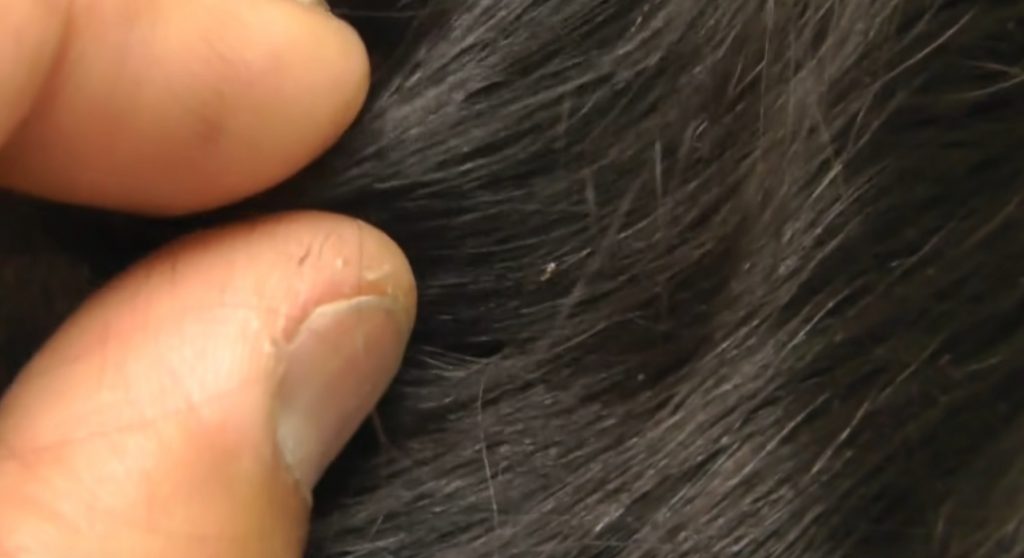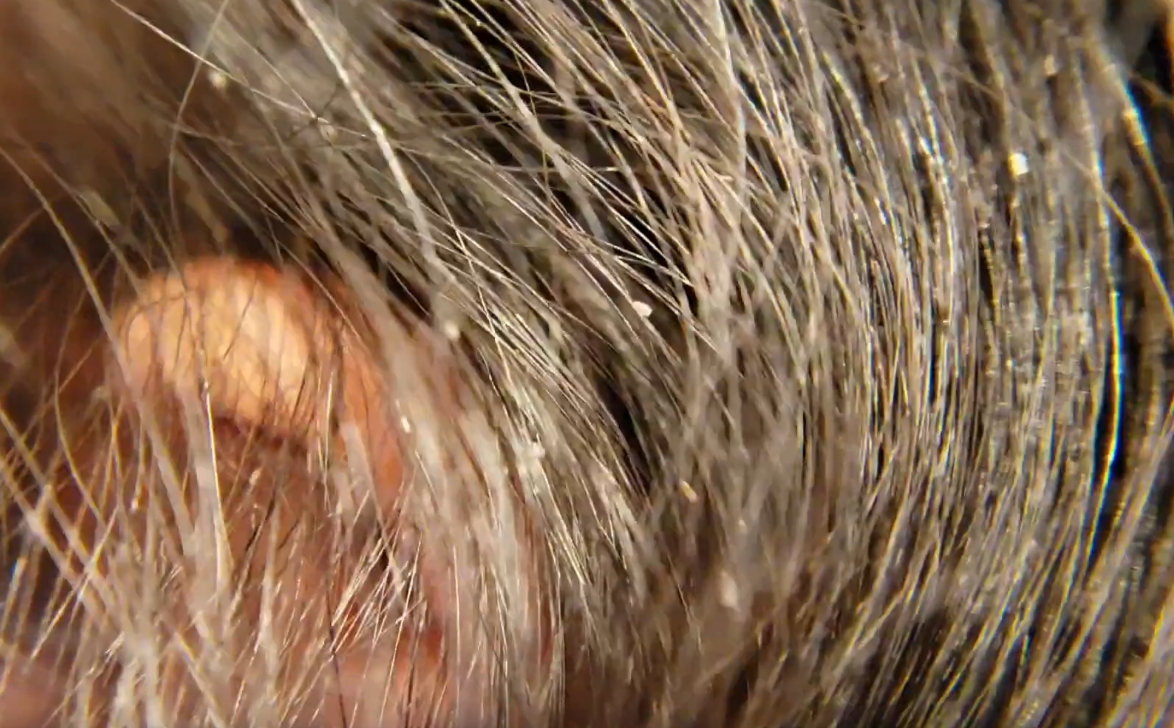Dandruff and nits are both conditions that can be found on the scalp. They can be pretty annoying because they cause itching, scratching, and even hair loss. So, how do you tell the difference between nits and dandruff? And more importantly, how do you get rid of them for good? In this blog post, we will discuss the differences between nits and dandruff and how to get rid of them once and for all!
Lice vs Dandruff: Knowing the Difference
Contents
Lice and dandruff might seem similar at first glance, but they’re worlds apart. Both can cause an itchy scalp, but that’s where the similarities end. Let’s dive into the nitty-gritty of these two distinct conditions.
What are Lice?
Lice are tiny, wingless insects that set up shop in human hair, feasting on blood from the scalp. Akin to uninvited guests, they’re notoriously difficult to shake off. They’re a cause for concern, particularly among school-age children, due to their ability to spread like wildfire via direct contact.

Consider lice as a tiny army invading your scalp, which can lead to symptoms such as:
- Intense itching and redness
- The presence of small, white eggs (nits) attached to the hair shaft
- Visible movement on the scalp or within the hair
Though lice can be an uncomfortable and unnerving experience, the good news is they’re easier to evict than dandruff. Over-the-counter and prescription lice treatments are usually effective in eliminating these pesky invaders. However, it’s crucial to consult a doctor as soon as you suspect a lice infestation.
What is Dandruff?
Dandruff, on the other hand, is a common skin condition that manifests as small, white, or yellow flakes of dead skin falling from the scalp. Unlike lice, it isn’t contagious, and it’s often triggered by dry skin or specific skin conditions, such as seborrheic dermatitis.
Some of the typical dandruff symptoms include:
- Itching and dryness on the scalp
- Visible flakes falling from the scalp or landing on your clothing
Dandruff can be a stubborn and persistent issue. While over-the-counter dandruff shampoos or scalp treatments can provide relief, seeing a doctor is advisable if the condition does not improve after several weeks.
Spotting the Difference
You might be wondering: how can you tell the difference between lice and dandruff? Well, there are a few key differences:
- Appearance: Lice eggs are small, white, and cling to the hair shaft, typically close to the scalp. Dandruff flakes are larger and can be either white or yellow.
- Movement: Lice can be seen moving on the scalp or in the hair. In contrast, dandruff flakes simply fall from the scalp.
- Itching: If you have lice, the itching is likely to be more intense due to the irritation caused by lice bites. Dandruff, however, typically causes less severe itching.
| Head Lice | Dandruff | |
|---|---|---|
| Definition | Small, wingless insects that live on the scalp and feed on human blood. | Small, white flakes of dead skin that shed from the scalp. |
| Appearance | Lice are visible as tiny bugs crawling in the hair. Their eggs (nits) attach to hair shafts close to the scalp. | Dandruff appears as white or yellow flakes that fall off the scalp easily. |
| Location | Found close to the scalp, attached to the hair shaft. | Can appear anywhere on the scalp. |
| Movement | Lice move. If you see something moving in your hair, it’s likely lice. | Dandruff does not move. |
| Transmission | Can spread through direct contact with infested hair or personal items (like combs, hats, etc.). | Not contagious. Often caused by dry skin, overgrowth of yeast on the scalp, or certain skin conditions. |
| Symptoms | Intense itching, redness on the scalp, a tickling feeling of something moving in the hair, irritability, and difficulty sleeping (lice are more active in the dark). | Itching and white, oily-looking flakes of dead skin in your hair and on your shoulders. |
| Diagnosis | By visual inspection, using a fine-toothed comb to find lice or their nits. | By visual inspection, looking for white or yellow flakes that fall off the scalp easily. |
| Treatment | Over-the-counter or prescription lice treatments (shampoos, creams, lotions), combing wet hair with a fine-toothed nit comb, washing infested items in hot water. | Over-the-counter dandruff shampoos or scalp treatments, prescription shampoos if necessary, maintaining a balanced diet and managing stress. |
Please note that if you have persistent symptoms or if the condition worsens despite treatment, you should consult a healthcare provider.
Head Lice vs. Dandruff: Unveiling the Differences
When your head itches, the immediate suspects are usually dandruff and head lice. Despite causing similar discomfort, these two conditions have different causes and symptoms. Let’s explore the distinct features of each and how to identify them effectively.
Recognizing Head Lice
Head lice are tiny, blood-sucking insects that make a home on your scalp. It’s like hosting an unwelcome mini convention of vampires right on top of your head! Here are some hallmarks of a lice infestation:
- Persistent itching: Lice bites can cause intense itchiness, often more severe than what you’d experience with dandruff.
- Appearance of nits: If you find small, white eggs (affectionately known as nits) attached to hair strands near the root, you’re likely dealing with lice.
- Feeling of movement on your scalp: Some people report a tickling sensation or the feeling of something moving in their hair. That’s lice having a party up there!
When it comes to evicting these uninvited guests, over-the-counter or prescription medications like permethrin, Malathion, or pyrethrum are often effective. Just remember to follow the instructions diligently and repeat the treatment as necessary.
Spotting Dandruff
Dandruff, on the other hand, is a skin condition caused by an overgrowth of a fungus called Malassezia globosa. This fungus enjoys a feast on the oils produced by your scalp. When it oversteps its boundaries, dandruff flakes form.
Dandruff manifests through:
- Flaking: Small flakes of skin in your hair or on your clothing are telltale signs of dandruff.
- Itchy scalp: While not as intense as lice-induced itching, dandruff can still cause a nagging itch.
- Scaly scalp: If your scalp feels oily and scaly, dandruff might be your culprit.
Managing dandruff often involves using a medicated shampoo containing selenium sulfide or zinc pyrithione. A dandruff brush can also assist in removing dead skin cells from your scalp.
Prevention is Better Than Cure
Both lice and dandruff can be kept at bay with good hygiene practices. Regular hair washing and avoiding close head-to-head contact can help prevent lice. For dandruff, maintaining a balanced diet and managing stress can be beneficial.
However, if someone in your household gets head lice, immediate treatment for all involved is crucial. Lice don’t discriminate and will happily jump from one head to another!
Distinguishing Between Lice and Dandruff
Lice and dandruff can sometimes look similar, causing confusion. Here’s how you can tell them apart:
- Visibility: While both may be hard to see, dandruff flakes are usually more visible as they fall off the scalp in large amounts. Nits, on the other hand, stick to hair shafts and are more challenging to spot.
- Location: Dandruff can appear anywhere on the scalp, whereas nits are often located close to the scalp, attached to the hair shaft.
- Movement: If it moves, it’s lice. Dandruff flakes do not move on their own.
Head Lice vs. Dandruff: Diagnosis and Treatment
Scratching your head wondering if you have head lice or dandruff? Let’s dive into the tell-tale signs of each and discuss the best treatment options.
Diagnosing Head Lice and Dandruff
The primary way to identify if you’re dealing with lice or dandruff is a visual inspection of your scalp. Here’s what you should look for:
- Head Lice: Tiny bugs crawling in your hair or white specks (nits) on the roots of your hair are clear signs of lice.
- Dandruff: Larger flakes that are white or yellow and fall off easily when you brush your hair typically indicate dandruff.
If you’re still unsure after the visual inspection, a healthcare professional can provide an accurate diagnosis and help establish a suitable treatment plan.
Check out this informative video for more on the differences between head lice and dandruff:
Treating Head Lice
There are various ways to show lice the exit door, with lice shampoo being the most common. Both over-the-counter options and stronger prescription treatments are available.
Remember to follow the instructions on the bottle to the letter, including thoroughly rinsing out the shampoo and repeating the treatment after seven to ten days.
You should also clean items that may be infested with lice, such as brushes, combs, hats, pillows, and bedding. Hot water or dry cleaning usually does the trick.
Prescription Shampoo
Prescription shampoos like those containing Malathion can be potent allies against lice. Using it twice, seven days apart, can help ensure a lice-free scalp. However, be mindful of scalp irritation from improper use.
Medication
Malathion, also available in both over-the-counter and prescription forms, is a common anti-lice medication. Another one is Lindane, a prescription-only medication not recommended for those with cuts or sores on the scalp or children younger than two years old.
Permethrin
Over-the-counter insecticide Permethrin comes in cream or lotion form and can be applied to the hair and scalp once. Make sure you follow the instructions carefully.
Home Treatment
Home remedies include combing your hair with a fine-toothed or nit comb, or soaking your hair in vinegar for 30 minutes before rinsing and combing. Some people recommend mayonnaise or olive oil, but their effectiveness is questionable.
Treating Dandruff
Just like with lice, dandruff can be treated with specially formulated shampoos available over-the-counter or via prescription. Following the instructions on the bottle is crucial, as is repeating the treatment in seven to ten days.
Shampoos containing Ketoconazole or Selenium Sulfide are common options for treating dandruff. Remember to read the instructions carefully to avoid scalp irritation.
Whether you’re dealing with lice or dandruff, remember to clean any items that could harbor these pests, like brushes, combs, hats, pillows, and bedding. It’s also a good idea to have your carpets and furniture cleaned to prevent any potential spread.
Comparative Analysis: Head Lice vs. Dandruff
Distinguishing between head lice and dandruff is important, not only for treatment purposes but also for prevention and understanding the overall impact on the affected individuals. These two conditions, while presenting similar symptoms such as itchy scalp, are distinct in their causes, prevalence, and demographic patterns. The table below provides a comprehensive comparison of head lice and dandruff based on recent studies and reports.
| Head Lice | Dandruff | |
|---|---|---|
| Prevalence | CDC estimates 6-12 million infestations each year in the U.S. among children aged 3 to 11 years | Affects about half of the adult population, peaking around age 20 and becoming less prevalent after age 50 |
| Gender Specificity | Girls get head lice more often than boys, likely due to more frequent head-to-head contact | Men are more likely to have dandruff than women, possibly due to larger oil-producing glands |
| Transmission | Spread through head-to-head contact or sharing personal items like hats, combs, or bedding. Lice crawl, they can’t hop or fly | Not contagious, caused by an overgrowth of a type of yeast called Malassezia |
| Relation to Hygiene | Lice infestations have nothing to do with personal hygiene. They can affect anyone, regardless of cleanliness or living conditions | Dandruff is not related to personal hygiene, but stress and cold weather conditions can increase its severity |
| Lifespan Prevalence | Not specified | About 50% of people have dandruff at some point in their lives, as per a study in the Journal of Clinical and Investigative Dermatology |
Despite the common symptom of an itchy scalp, the two conditions differ significantly in causes, transmission methods, and affected demographics.
Frequently Asked Questions (FAQs)
Here are some of the most common questions about lice and dandruff:
What do lice look like vs. dandruff?
Lice eggs, also known as nits, are tiny, oval-shaped, and range from yellow to light brown in color. They stick firmly to the hair shaft and can be hard to see, especially in dark hair. On the other hand, dandruff flakes are larger and whiter. They don’t stick to the hair and easily flake off. If you’re unsure, using a magnifying glass can help you take a closer look!
How do you check for lice vs. dandruff?
Checking for dandruff is relatively straightforward – if you see white flakes on your scalp or hair, it’s likely dandruff. To check for lice, however, you’ll need a fine-toothed comb. Carefully comb through your dry hair, from the roots to the tips. If you spot small brown bugs or eggs stuck firmly to the hair shafts, you may have lice. If you’re still unsure, don’t hesitate to consult a healthcare professional or your local pharmacist.
How big is dandruff vs. lice?
Dandruff flakes are much larger, usually about the size of a quarter. In contrast, lice eggs or nits are tiny – about the size of a sesame seed. This size difference is another way to differentiate between the two.
How do you know if it’s lice or dandruff?
If you’re seeing white flakes on your scalp or in your hair, it’s probably dandruff. To check for lice, comb through your dry hair with a fine-toothed comb. If you spot small brown bugs or nits stuck to the hair shafts, you likely have lice. A magnifying glass can be handy for a closer look. However, if you’re still uncertain, it’s best to consult a healthcare professional or pharmacist for an accurate diagnosis.


